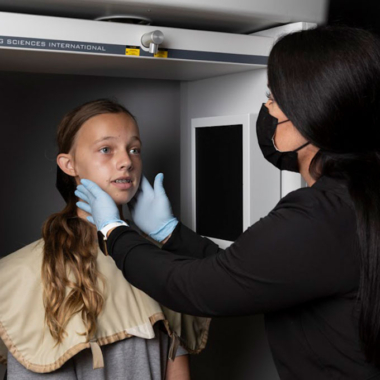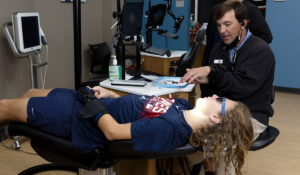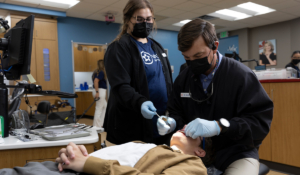Orthodontic Braces for All Ages in Gainesville
We treat every braces patient with a customized plan using traditional metal or Damon braces to ensure you’re getting the best possible orthodontic option—with results you’re proud to share. Learn more when you schedule your FREE consultation today with an orthodontist in Gainesville.

Available Braces Options

Traditional Metal Braces
Metal braces are the most common type and have been used to straighten teeth for centuries. Made of high-grade stainless steel and combined with elastic ties or bands to gently move teeth as prescribed, traditional metal braces can help create that perfect smile.
Traditional metal braces are more comfortable than they’ve ever been, and they’re a great choice for phase I treatment. Another benefit: Wilson Orthodontics can start your traditional metal braces treatment the same day you come in!
Damon Braces
Damon braces are a popular alternative to traditional metal braces. These braces use “self-ligating” technology, which means there’s no need for elastic ties. Damon braces gently shift teeth into the desired position and are often more comfortable—and sometimes work faster—than traditional braces.


Ceramic or Clear Damon Braces
Ceramic braces are less noticeable on the teeth because they’re either clear or tooth colored. Just as with traditional metal or Damon braces, ceramic brackets gradually realign your teeth to help perfect your smile. They’re popular with teens and adults because they’re a bit more discreet than metal braces.
Another low-profile option we offer is clear Invisalign® aligners which are just as effective as braces and offer you more flexibility when it comes to eating and drinking.


Let us help you when you book a free consult.
Braces FAQs
What foods should I avoid while I have braces?
There is really only a small list of foods to avoid while wearing braces. This is to avoid damaging the brackets or to prevent food particles from becoming trapped between the brackets and wires. Foods to avoid include:
- Chewy foods such as fruit leathers, beef jerky, or bagels
- Highly crunchy foods like raw carrots, chips, raw celery, and popcorn
- Sticky foods like caramel candy, licorice, and marshmallows
- Very hard foods like hard candy, hard breadsticks, or pizza crust
- Any food you have to bite into such as apples or corn on the cob (You can still enjoy these foods by slicing the apples or removing the corn from the cob!)
How do I brush my teeth with braces?
- Before brushing, do a quick rinse with water. This will dislodge any food particles stuck between the wires or brackets.
- Brush beginning at the gum line, using a 45-degree angle of approach. As you move towards the brackets, brush from both the top and the bottom, ensuring that the bristles reach under the wires and around the brackets. This process may take some extra time in the beginning, but once you are used to it, it will be routine for you.
- Follow up with thorough flossing. You will need to use precise and careful flossing techniques to make sure you do not dislodge or loosen the brackets or wires. Your doctor will help you perfect your flossing technique during your appointment.
Are braces painful? How do I ease the pain?
Generally, braces are not painful. However, you may feel a little sore or uncomfortable immediately after you first get them. This soreness is normal, and it will not last long.
A saltwater rinse can help relieve soreness and inflammation. Dissolve a single teaspoon of salt in a full cup of lukewarm water and swish around your mouth for a few minutes. If soreness persists, you can take an over-the-counter pain reliever such as ibuprofen or acetaminophen. If you experience lip, cheek, or tongue irritation in the weeks after getting braces, some wax can alleviate the problem quickly.
How long will I have to have braces?
The amount of time that you will need to wear braces varies and depends on several things (such as the severity of your bite problem). Most patients need to wear braces for 12 to 24 months, but this can be shorter or longer depending on your case. We’ll discuss this with you and give you a general idea of what you can expect.
After several months of wearing braces, we can measure progress more easily, and we can more accurately update you regarding how much longer you can expect to wear braces.
Can I get braces that are less noticeable?
The most popular option for less noticeable orthodontic treatment is clear Invisalign® aligners. Comfortable and discreet, clear aligners are an effective way to treat complex cases for teens and adults. The best part? They are covered by most insurance plans and the overall cost is comparable to traditional braces!
How much do braces cost in Gainesville?
The cost of braces depends on which type of braces you choose, how long you will need treatment, and other factors unique to your case. Wilson Orthodontics offers payment plans that can work with your budget and get you the orthodontic care you need.
Find Us Conveniently Located in Gainesville
With a convenient location in Gainesville, we are proud to serve the communities of Flowery Branch, Oakwood, Dawsonville, Dahlonega, and Jefferson.


